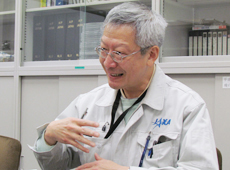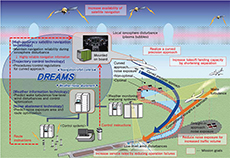
Towards “Seamless Air"
— Tell us about the DREAMS project development process.
We began to formulate the technical objectives and high-level concepts in mid-2009, and started the actual project in 2012. In the first year, we completed system design and manufacturing, and since 2013 we've been running validation experiments. We have already achieved our initial development goals, and will finish the project with a successful final internal evaluation. Our results will be reported to the International Civil Aviation Organization (ICAO), an UN specialized agency which oversees civil aviation around the world.
— What is the history behind the DREAMS project?

Air traffic has been increasing, primarily driven by the rapidly growing economies in Asia. By 2030, the total amount of global air traffic is expected to double. This represents not only an increase in the number of passengers and the amount of cargo, but also the number of aircraft, since the industry is moving from large airliners to small- and medium-sized aircraft. In the past, only large airplanes could travel long distances, but modern planes are more lightweight, thanks to the use of composite materials, and that allows medium-sized aircraft to travel longer distances. More flights is more convenient for passengers, but this puts a strain on airport capacity. It's not simply a matter of building more runways; Today's air traffic management systems won't be able to keep up.
In 2003, ICAO proposed the Global Air Traffic Management (ATM) Operational Concept, which would overhaul air traffic management to allow aircraft to operate more safely and efficiently. The idea is to create a seamless global ATM system, with common standards, to be operational in 2025.
This sparked many countries to begin developing new operational systems. The United States has been working on the Next Generation Air Transportation System (NextGen), Europe is pursuing the Single European Sky ATM Research Project (SESAR), and Japan is developing the Collaborative Actions for Renovation of Air Traffic Systems (CARATS). To achieve the goals of the CARATS initiative, Japan has established 46 policies, including improving safety, supporting increased air traffic, improving convenience, and conserving the environment. JAXA took on the goals and challenges that were most appropriate to its technical capability, and five of these are the focus of the DREAMS project.
Focus on five challenges
— What are these five challenges?

Conceptual view of DREAMS weather, noise abatement, satellite navigation and trajectory control technologies

Conceptual view of DREAMS disaster-relief/small-aircraft operation technology
The five challenges are:
- “weather information technology" that can predict wake turbulence and low-level wind disturbances, helping reduce wait times between takeoffs and landings;
- “noise abatement technology" that can predict the effects of airplane noise and help set quieter approach paths into airports;
- “high-accuracy satellite navigation technology" that maintains the reliability of GPS navigation even during periods of heavy solar activity;
- “trajectory control technology" that enables curved-path approaches based on GPS navigation;
- “aircraft operation technology for disaster relief", which will improve flight management and information sharing for rescue aircraft. This technology is unique to Japan, as it is not being developed in the U.S. and European programs.
The major goal is to create algorithms that will later become international standards.
— What do you expect to achieve with these technologies?
We expect to expand airport capacity and increase the number of flights in and out of airports, while at the same time improving safety, reducing the environmental impact of civil aviation, and improving the efficiency of rescue aircraft.
— Please tell us about future plans for the technology.
Some of the technology developed by the DREAMS project is already being adopted by private companies. For example, there is a new terminal device available for installation in aircraft that is compatible with the Disaster Relief Aircraft Information Sharing Network (D-NET). The Low-level Turbulence Advisory System (LOTAS), which JAXA has been developing through DREAMS project's “weather information technology", is expected to go into operation at the Japan Meteorological Agency in April 2016. We will continue to support the transition of these technologies to practical use. The DREAMS project is funded by citizens through the taxes they pay, so we fully intend to provide benefit to society with this project's achievements.
Yasuhiro Koshioka, Ph.D.

Project Manager, DREAMS Project Team, Aeronautical Technology Directorate, JAXA
Dr. Koshioka joined JAXA in 2012, after working for an aircraft manufacturer. He also is involved in the development of technology to reduce the air resistance of aircraft.
[ April 1, 2015 ]